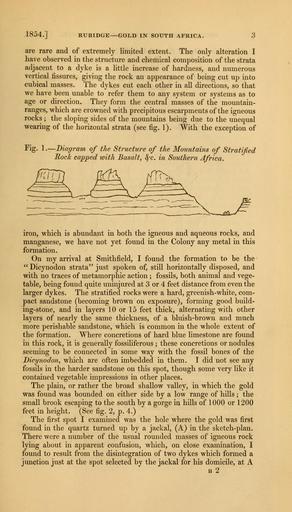MAKE A MEME
View Large Image

| View Original: | The_Quarterly_journal_of_the_Geological_Society_of_London_(12711282445).jpg (1828x3200) | |||
| Download: | Original | Medium | Small | Thumb |
| Courtesy of: | commons.wikimedia.org | More Like This | ||
| Keywords: The Quarterly journal of the Geological Society of London (12711282445).jpg 1854 RUBIDGE � GOLD IN SOUTH AFRICA 3 <br> are rare and of extremely limited extent The only alteration I <br> have observed in the structure and chemical composition of the strata <br> adjacent to a dyke is a little increase of hardness and numerous <br> vertical fissures giving the rock an appearance of being cut up into <br> cubical masses The dykes cut each other in all directions so that <br> we have been unable to refer them to any system or systems as to <br> age or direction They form the central masses of the mountain- <br> ranges which are crowned with precipitous escarpments of the igneous <br> rocks ; the sloping sides of the mountains being due to the unequal <br> wearing of the horizontal strata see fig 1 With the exception of <br> Fig- 1 � � Diagram of the Structure of the Mountains of Stratified <br> Rock capped with Basalt c in Southern Africa <br> iron which is abundant in both the igneous and aqueous rocks and <br> manganese we have not yet found in the Colony any metal in this <br> formation <br> On my arrival at Smithfield I found the formation to be the <br> Dicynodon strata just spoken of still horizontally disposed and <br> with no traces of metamorphic action ; fossils both animal and vege- <br> table being found quite uninjured at 3 or 4 feet distance from even the <br> larger dykes The stratified rocks were a hard greenish-white com- <br> pact sandstone becoming brown on exposure forming good build- <br> ing-stone and in layers 10 or 15 feet thick alternating with other <br> layers of nearly the same thickness of a bluish-brown and much <br> more perishable sandstone which is common in the whole extent of <br> the formation Where concretions of hard blue limestone are found <br> in this rock it is generally fossiliferous ; these concretions or nodules <br> seeming to be connected in some way with the fossil bones of the <br> Dicynodon which are often imbedded in them I did not see any <br> fossils in the harder sandstone on this spot though some very like it <br> contained vegetable impressions in other places <br> The plain or rather the broad shallow valley in which the gold <br> was found was bounded on either side by a low range of hills ; the <br> small brook escaping to the south by a gorge in hills of 1000 or 1200 <br> feet in height See fig 2 p 4 <br> The first spot I examined was the hole where the gold was first <br> found in the quartz turned up by a jackal A in the sketch-plan <br> There were a number of the usual rounded masses of igneous rock <br> lying about in apparent confusion which on close examination I <br> found to result from the disintegration of two dykes which formed a <br> junction just at the spot selected by the jackal for his domicile at A <br> B 2 35614557 110213 51125 Page 3 Text v 11 http //www biodiversitylibrary org/page/35614557 1855 Geological Society of London NameFound Dicynodon NameConfirmed Dicynodon EOLID 4522858 NameBankID 4142930 NameFound Dicynodon strata Biodiversity Heritage Library The Quarterly journal of the Geological Society of London v 11 1855 Geology Periodicals Smithsonian Libraries bhl page 35614557 dc identifier http //biodiversitylibrary org/page/35614557 smithsonian libraries Information field Flickr posted date ISOdate 2014-02-23 Check categories 2015 August 26 CC-BY-2 0 BioDivLibrary https //flickr com/photos/61021753 N02/12711282445 2015-08-26 21 01 27 cc-by-2 0 PD-old-70-1923 The Quarterly journal of the Geological Society of London 1855 Photos uploaded from Flickr by Fæ using a script | ||||